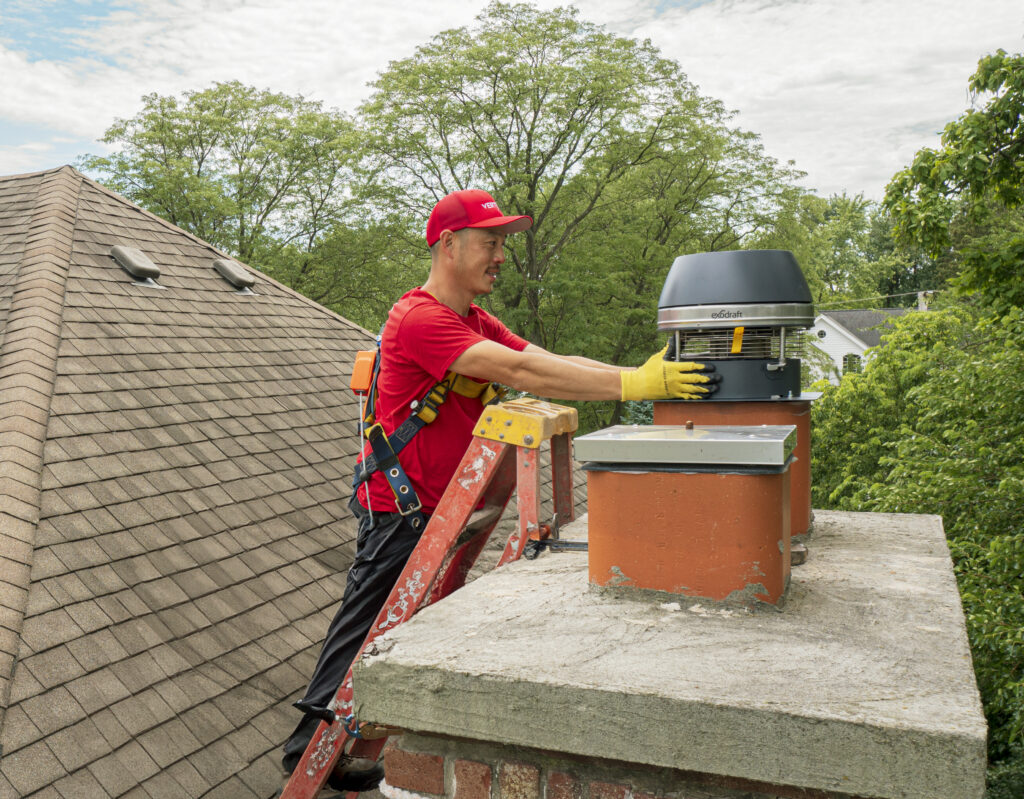
What’s a Chimney Cricket?
A chimney cricket, sometimes called a roof cricket, is a mini peaked roof that sits behind your chimney. Essentially, it’s a small peak jutting from your main roof that sits directly against the backside of the chimney. The purpose of this cricket peak is to help channel water away from your chimney’s masonry. Where the downward slope of your roof meets the brick structure of your chimney, there’s a crevice, and in that crevice, water can collect. Water should be directed away from all parts of your home and your chimney is no exception. Chimney crickets are made from materials like galvanized steel, stainless, steel, or aluminum. Then, the crickets are shingled with the same shingles that your roof has, so everything is flush and matching. The shingles also provide an extra layer of protection in the event of falling tree limbs or debris. Skilled contractors will usually install a water and an ice shield behind the cricket, sometimes using a synthetic felt that’s placed on top of the leak prevention barrier. Vents are not usually needed during chimney cricket installation because it doesn’t sit on the top of the roof. Some contractors may install a rolled ridge vent if the roof line requires it. Metal valleys will be used as flashing when installing the cricket, flashing it to the chimney’s side wall, if any, or the siding.
The Usefulness of a Chimney Cricket
While a crevice between the chimney and the downward slope of the roof might not seem like a big deal, lingering pools of water can cause expensive damage. Common issues that arise for many homeowners are foundational problems in basements, leaky attics, structural issues made evident in stains that appear on walls, and chimneys that leak or have cracks in their masonry. A chimney cricket disrupts the flow of water because of its sharply angled sides. Because its shaped like a three-dimensional triangle, the flowing rainwater is channeled down the abruptly angled sides, never touching your chimney as it descends off of your roof. There’s no chance for the water to collect in this tricky spot because of the cricket and thus there’s no future of water damage, expensive masonry repair work, and worries about further damage to adjacent structures or roofing systems.Protecting Your Chimney
A chimney cricket isn’t just useful during heavy summer storms or the casual passing rains. During the winter, a chimney without a cricket behind it invites snow and ice to pile in this sneaky spot. Snow can easily rest in this area behind your chimney, even if you’ve cleared off your roof after a heavy snowfall it can be nearly impossible to properly reach. If the temperatures dip below freezing, you’ve got an even bigger problem than wet snow behind your chimney, you could experience a potential ice dam as the snow collects and the water refreezes. An ice dam is a heavy amount of ice that prevents water from properly running down your roof. This can cause serious damage to your chimney if you don’t have a cricket in place to discourage snow and ice from forming in this spot. Water can penetrate into your chimney and your roof if an ice dam forms, but a chimney cricket can prevent this from occurring because it curbs water from pooling at the base of the chimney altogether.
Preventing Water Damage
If you think about it, installing a chimney cricket is a small act in preventing vast water damage. This mini peak that sits behind your chimney can stop the deterioration of the chimney’s bricks, mortar, and chimney flue as well as the interior of your home. That’s a miniscule price to pay to ensure a lifetime of good chimney health and your home’s lasting structural integrity. If your chimney is located on a downward slope of the roof, then you’ll need to include a chimney cricket in your roof’s flashing system to stop water from accumulating at its base. You’ll not just protect your chimney, but the roof and home, too. Some building codes require that a chimney cricket is installed on chimneys, especially if the chimneys are larger with over width 30 inches. Pricing for the installation of a chimney cricket varies. The cost of labor and availability of skilled contractors fluctuate the most depending on where you live, which makes your geographical location perhaps the most influential factor in overall cost. There’s also the question of accessibility. The more difficult it is to access this part of your roof for the installation, the more expensive the overall cost can be.
